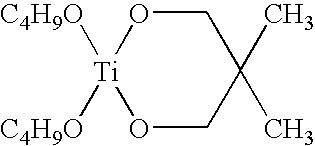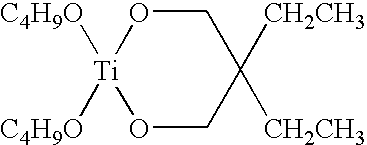Polymer-containing organo-metal catalysts
- Summary
- Abstract
- Description
- Claims
- Application Information
AI Technical Summary
Problems solved by technology
Method used
Image
Examples
example 1
[0107] A mixture of 50.0 grams (10.72 mmol hydroxyl group) of poly(ethylene-ran-1,2-butylene) mono-ol (approximate number average molecular weight Mn=4200 Daltons, molecular weight units omitted hereinafter) and approximately 30 mL of toluene was charged to a 250-mL three-neck round-bottom flask equipped with a distillation adapter, a magnet stirring bar, and a nitrogen inlet. The mixture was stirred and heated to reflux under nitrogen during which time approximately 20 mL of toluene was removed by distillation. The mixture was then cooled to about 100.degree. C., and 0.76 grams (2.68 mmol) of tetra-isopropyl titanate was added to the mixture via a syringe. The corresponding molar ratio of hydroxyl group of the polymer to titanium was approximately 4.00:1. The mixture was heated and kept under reflux for an additional 30 minutes at about 150.degree. C., and then isopropyl alcohol was removed by distillation at a distillation temperature within a range from about 85.degree. C. to 90....
example 2
[0108] The procedure of Example 1 was employed for the reaction of 50.0 grams (58.39 mmol hydroxyl group) of polyethylene monoalcohol (approximate number average molecular weight Mn=856) with 4.06 grams (14.29 mmol) of tetra-isopropyl titanate in toluene at reflux temperature. The corresponding molar ratio of hydroxyl group of the polymer to titanium was about 4.09:1. After removal of isopropyl alcohol and toluene and upon cooling, the clear and viscous liquid solidified. The yield was 49.0 grams, or about 98.8% of the theoretical maximum. The white solid product has a melting temperature of approximately 108.degree. C. The product contains the compound, tetrakis-poly(ethylene) titanate, having the following formula: 27
example 3
[0109] The procedure of Example 1 was employed for the reaction of 40 grams (42.15 mmol hydroxyl group) of polyethylene-block-poly(ethylene glycol), having a number average molecular weight Mn of about 875 and containing 21% by weight of ethylene oxide units, with 2.97 grams (10.43 mmol) of tetra-isopropyl titanate in approximately 30 mL of toluene at reflux temperature. The corresponding molar ratio of hydroxyl group of the polymer to titanium was about 4.04:1. After removal of isopropyl alcohol and toluene and upon cooling, the clear and viscous liquid solidified. The yield was 39.2 grams, or about 98% of the theoretical maximum. The white solid product has a melting temperature of approximately 106.degree. C. The product contains the compound, tetrakis-[poly(ethylene)-block-poly(ethylene glycol)] titanate, having the following formula: 28
PUM
| Property | Measurement | Unit |
|---|---|---|
| Angle | aaaaa | aaaaa |
| Angle | aaaaa | aaaaa |
| Fraction | aaaaa | aaaaa |
Abstract
Description
Claims
Application Information
 Login to View More
Login to View More - R&D
- Intellectual Property
- Life Sciences
- Materials
- Tech Scout
- Unparalleled Data Quality
- Higher Quality Content
- 60% Fewer Hallucinations
Browse by: Latest US Patents, China's latest patents, Technical Efficacy Thesaurus, Application Domain, Technology Topic, Popular Technical Reports.
© 2025 PatSnap. All rights reserved.Legal|Privacy policy|Modern Slavery Act Transparency Statement|Sitemap|About US| Contact US: help@patsnap.com



